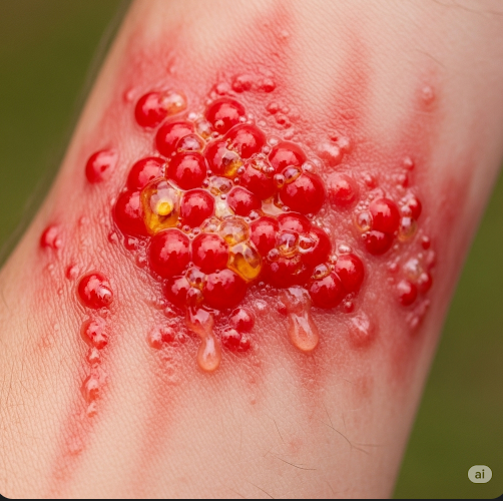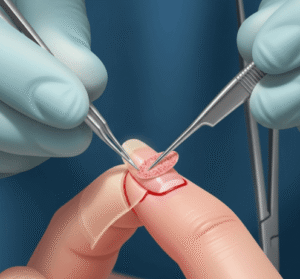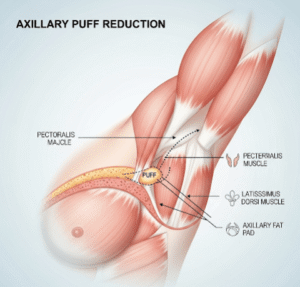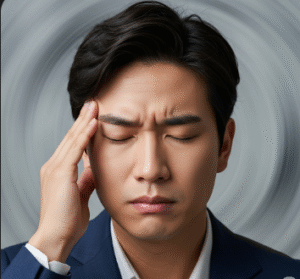Overview
Poison sumac rash is a painful, itchy skin reaction caused by contact with the urushiol oil found in poison sumac plants. While less common than poison ivy or oak, poison sumac typically causes a more severe allergic response, often with widespread blisters and intense inflammation. The rash itself is not contagious, but prompt treatment is important to reduce discomfort and prevent complications.
What is Poison Sumac Rash?
Poison sumac rash is a form of allergic contact dermatitis, which occurs when skin comes into contact with urushiol — an oily toxin found in poison sumac, poison oak, and poison ivy. Poison sumac is a woody shrub or small tree that grows in swampy, humid environments, and all parts of the plant contain urushiol.
The allergic reaction develops 12–72 hours after exposure, starting as redness and swelling, followed by severe itching and blistering. Although the rash may look like it’s spreading, this is due to varying levels of exposure — not because the rash is contagious.
Symptoms
Symptoms of poison sumac rash may vary in severity depending on the level of exposure and the person’s sensitivity:
- Red, swollen skin
- Severe itching or burning sensation
- Fluid-filled blisters, often in streaks or patches
- Oozing and crusting as blisters break
- Swelling of the face, eyelids, or genitals in severe cases
- Pain or tenderness in affected areas
- Fever or chills (rare, may indicate secondary infection)
The rash usually lasts 1 to 3 weeks, but symptoms can persist longer in severe cases.
Causes
The cause of the rash is contact with urushiol oil, which can be transmitted in several ways:
- Direct contact with poison sumac leaves, stems, roots, or berries
- Touching contaminated objects, such as clothing, tools, or pet fur
- Inhaling smoke from burning poison sumac (can irritate lungs and eyes)
- Transferring oil to other body parts before washing
Only a small amount of urushiol is needed to trigger a reaction — even less than a grain of salt can cause a rash in sensitive individuals.
Risk Factors
You are more likely to develop a poison sumac rash if you:
- Spend time in swampy, wooded, or marshy areas
- Work in landscaping, farming, forestry, or outdoor construction
- Have a history of sensitivity to urushiol (e.g., from poison ivy or oak)
- Touch contaminated clothing, pets, or gear
- Burn brush that may contain poison sumac
- Don’t wash exposed skin or items quickly after outdoor exposure
Complications
While poison sumac rash usually resolves on its own, complications may occur if the reaction is severe or improperly treated:
- Secondary bacterial infections due to excessive scratching
- Widespread swelling or blistering
- Scarring or skin discoloration in severe reactions
- Breathing difficulties if urushiol is inhaled
- Eye irritation or vision problems if the oil gets into the eyes
Seek medical attention immediately if you experience facial swelling, difficulty breathing, or signs of infection (fever, pus, increased pain).
Prevention
Preventing poison sumac rash involves avoiding exposure to urushiol and practicing good hygiene after outdoor activity:
- Learn to identify poison sumac (7–13 leaflets per stem, reddish stems, grows in wetlands)
- Wear protective clothing (long sleeves, gloves, boots)
- Apply barrier creams like bentoquatam before exposure
- Wash exposed skin immediately with soap and cool water
- Clean clothes, tools, and pets that may have contacted the plant
- Never burn poison sumac, as inhaling urushiol can be dangerous
Treatment Options in Korea
South Korea provides high-quality dermatology care for contact dermatitis, including poison sumac rash, in both hospital and clinic settings.
1. At-Home and Over-the-Counter Treatment (Mild Cases)
- Cool compresses to reduce inflammation and itching
- Oatmeal baths for skin relief
- Calamine lotion or hydrocortisone cream for itching
- Oral antihistamines (e.g., loratadine, cetirizine) to relieve allergic symptoms
2. Medical Treatment (Moderate to Severe Cases)
- Prescription corticosteroids: topical, oral (e.g., prednisone), or injectable
- Antibiotics: for skin infections due to scratching
- Systemic antihistamines: for widespread or intense itching
- Emergency treatment for severe allergic reactions or swelling around the eyes, mouth, or airway
3. Care Facilities in Korea
Major hospitals and dermatology clinics like Samsung Medical Center, Severance Hospital, Asan Medical Center, and Seoul National University Hospital offer:
- Dermatologist consultations for allergic and inflammatory skin conditions
- English-speaking services for international patients
- Patch testing for recurring allergic contact dermatitis
- Access to advanced medications and personalized treatment plans













